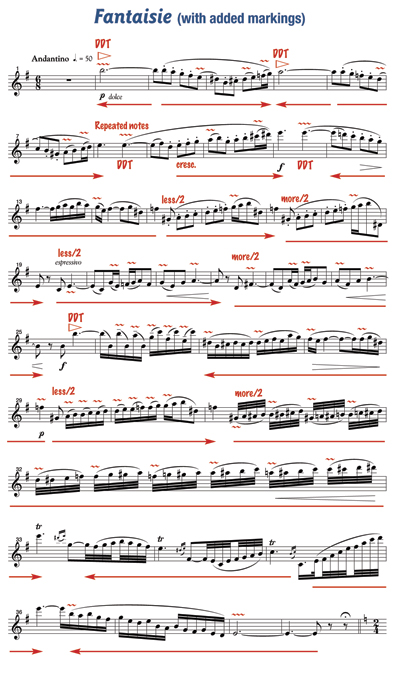Listening should be part of every musician’s daily practice routine. Of course listening to oneself is essential, but listening to others is beneficial too. Schedule a time each day when you are fresh and can listen without being disturbed. A note pad or journal is helpful for writing observations about what you hear and want to incorporate in your playing
This project is not about listening to learn a musical composition; it is about developing critical listening skills. Learning these skills will help you become an expressive performer and of course a better teacher.
Select the Artist and the Music
Select a recording of a flutist whose playing you admire. Choose a composition that is melodic in nature such as the theme section of one of the many virtuoso Romantic themes with variations, the Gluck Minuet and Spirit Dance, or a salon piece by Bizet, Donjon, Faure, or other composer. A homophonic piece with both a simple melodic line and accompaniment is less distracting when listening for certain elements of the performance. Listen with the full flute and piano score. If the score is in public domain (as it will be in most cases of works published before 1923), check www.imslp.org for a free download.
Passive vs. Active Listening
Passive listening is what people do most of the day. For example, when someone walks into a room and turns on the television while doing something else, the chatter of the program becomes background noise to the other activities. Similarly, people often hear but do not focus on the radio in the car or music playing in stores.
Active listening is accomplished when you listen with concentration. You tune into the music. This is a skill which can be developed. To be successful with this project, select a location where you can listen undisturbed and turn up the volume without disturbing any one.
Gabriel Fauré (1845-1924)
To illustrate how to undertake this process, take a look at Andantino from Gabriel Fauré Fantaisie for flute and piano, Op. 79 (1898). In 1893 Paul Taffanel, to whom the Fantaisie was dedicated, became flute professor at the Paris Conservatory. Fauré was the Paris Conservatory director at the time, and he and other French composers sought to improve the quality of the pedagogical repertoire. Fantaisie is a result of this goal.
Fantaisie is one of the first French flute pieces young flutists learn. It is a beautiful work that delights both performer and listener time and time again. On YouTube there are numerous recordings. Some are excellent, while others are wanting in flute performance basics. As your listening skills improve, you may find that you learn as much from the weaker performances as from the stronger ones.
The following process will improve listening skills and help students understand phrasing and flute fundamental concepts. This creates a sound foundation of knowledge that they can apply to other works in the repertoire.

Step 1: Tempo and Meter
The Fantaisie is written in E minor, and the tempo marking for the opening is andantino (q. = 50). According to the Harvard Dictionary “Andantino is the diminutive of andante, used mainly to characterize a short piece of andante tempo or character. If used as a tempo mark, it means a slight modification of andante.” The problem lies with the words slight modification. It could be interpreted to mean either a faster or slower tempo. Most musicians today interpret andantino as being a quicker tempo than andante. The marking of dotted quarter = 50 implies that the section should be played in two rather than in six with the first beat being the strongest and the second beat weaker.
Listen to the work concentrating on the chordal accompaniment. Notice whether the pianist follows the strength of the beat rule with the first beat being stronger and the second beat weaker. Is the accompaniment metronomically steady or is there some use of rubato? Listen again focusing on the flutist and ask the same questions. Do the performers play in 2 or in 6 throughout or are there places in 6? If you hear fluctuations, does it enhance or distract from the performance?
Step 2: Dynamics
First, take a look at the piano score and compare it to what you hear. Since this section of the piece is written in compound meter (each beat is divisible by three), decide whether the pianist plays the second part of each beat softer than the down beat. Is the third part of the beat in the piano part truly a silence as written? In the pedaling instructions the word simile at the end of the third bar indicates that the pianist should continue the same pedaling until bar 19. There the pedal varies and then resumes the initial instruction at bar 26 through the end of the section. The piano writing should be a steadying influence in this section of the Fantaisie, so a pianist who follows Fauré’s instructions carefully creates a strong skeleton onto which a flutist can add expressive playing.
The next step is to examine the dynamics in the flute part. The flute begins piano followed by the word dolce, or sweetly. (I have never seen the word dolce used with any dynamic other than piano.) On a separate piece of paper, write down all the dynamics in the flute part: p, f, mp, mf, f, p, f, mf, f, p. Use these dynamic clues to find the high or climax points in the music. Listen to the recording again paying special attention to this dynamic landscape.
When playing similar phrases (measures 15/16 and 17/18), vary the starting dynamic of each phrase for interest. In this case, play the first phrase of the two less or softer than the second since the overall contour is lower. This is marked less/2. If there were three similar phrases, it would be marked less/3.
Step 3: Shape of the Notes, DDT and Vibrato
The DDT rule (decay to the dot or tie) is useful to apply to the notes of longer value such as dotted half-notes, dotted quarter-notes, and longer note values with a tie. This rule also follows the instruction to play the strongest part of the note at the beginning of the note. Following this rule shapes the longer notes like a triangle. To remind students of this concept, mark longer dotted notes with a triangle or the abbreviation DDT.
Vibrato should start at the beginning of the note. Since the opening note is marked p dolce, the vibrato should be narrower than the flutist’s generic vibrato and a bit faster. To achieve the optimum cycle, practice six vibrato cycles = 50. All three of my teachers (Joseph Mariano, William Kincaid, and Julius Baker) suggested using six vibrato cycles per dotted quarter in compound meter as a starting point.
So often flutists begin this opening with no vibrato on beat one, and then by beat two there is a slight crescendo as the vibrato cycles start. If Fauré had wanted a vibrato crescendo on the first entrance of the flute, he would have written it that way.
The beginning of each of the longer notes should be clean and the attack not so strong as to make a rise in the pitch of the note. Likewise the end of the longer notes is equally important. If you decay to the dot or tie, you will quite naturally make a taper. Be sure to keep the tongue in position until the note is completed, or you run the risk of changing the tone color at a place where you least intend. Avoid glottal stops at the end of notes. Before a breath, end the taper of the note a little early (shorten the note value) so you can breathe quietly and re-enter gracefully. Unless the music is marked otherwise, enter more softly after a breath.
Listen to the work again and notice these details. Check whether the flutist applies the DDT rule, starts the vibrato cycles at the beginning of the notes, and creates tapers that are well-shaped and of the correct duration for musical breathing.
Step 4: Performance Marks
In the Andantino, the following performing marks are used: slur, single tongue, dots under a slur, and tenuto. The dots under a slur are played legato, but with a small articulatory silence between each note. Mariano was fond of double-tonguing passages like this to insure a good musical line. The tenuto notes are held or sustained, but with a bit of separation. The use of the tenuto markings in bar 26 highlights the main theme of the Andantino. An articulatory silence works well every time the articulation changes. The entire Andantino should not sound like all the notes on the page are played under one big slur.
Listen to the Andantino again checking the accuracy of the performer’s articulation marks. Each of the tongued notes under the slur should be treated exactly the same.
Step 5: Contour
Lay a thin sheet of typing paper over the flute part. Trace the note heads of each phrase as if connecting the dots in a children’s puzzle book. Examine the shape of each phrase. There are five common shapes for melodic contour. The first is the mountain shape. When playing a mountain-shaped phrase, start softly and make a slight crescendo or increase the energy of the notes to the top note of the shape and then diminuendo or decrease the energy back to the last note of the phrase.
For a valley-shaped phrase, start softly and make a slight crescendo or increase the energy of the notes to the lowest note and then diminuendo or decrease the energy back to the last note of the phrase. For contours that are coming down or going up, you might start softer and increase the dynamic and energy to the final note or do the opposite.
The performance choices for a turn-shaped contour relate to tempo. If the tempo is slow, then you can inflect as suggested for the valley and mountain shapes. If the tempo is fast, there may not be enough time to do much at all.
A general rule to follow is to let the notes get louder as the notes rise and softer as the notes go lower. Musicians usually follow this rule but on occasion sometimes not. Since Fauré was primarily a composer of songs and piano music, following the contour of the music is generally suitable for his style of writing. A good idea is to start by playing the contour and then if you chose, try the opposite.
Listen again for how the performer treats the contour. Do you agree or disagree with the choices?
.jpg)
Step 6: Coming and Going
Since the shape of the first notes decays or gets softer from the first beat, this is called coming away from one or the first beat. Notice that measures two and three follow the convention that notes of shorter value lead to notes of longer value. These notes should lead to the next long note or go towards the next note of longer value.
Label the music with an arrow to signify coming away from beat one or leading to the beat. (See the table below for an example of how to mark this.)
When playing the Andantino, many flutists move the end of their flutes aimlessly in the shape of a figure eight or in an up and down motion with each beat. While movement is excellent and prevents injury, random movement can destroy the musical line. Use movement that enhances the musical line of the phrase.
Stand with the left foot in front and the right foot in back with the toes pointing to 12:00 and 2:30/3:00 on a clock. Practice shifting your weight from the right back foot to the left front foot and then from the left front foot to the right back foot. When doing this, you will either be moving forward or moving back. Each of these movements is called a gesture. Playing a group of notes or a measure on one gesture smooths the melodic line. This type of movement prevents the flutist from unintentionally accenting unimportant notes through aimless movement.
Moving forward or going to a specific measure can be indicated in the music with an arrow pointing to the right. Moving back or coming away is shown with an arrow in the music pointing to the left. Practice these gestures with the chart below. For example, the first row indicates that measure two should come away from the beat. This suggests that you could play measure 2 while moving backwards from the left front foot to the back right foot. In measures 3 and 4 move from the back foot to the front foot. Continue to practice this intelligent movement for each line of the chart, placing a rest between each gesture. In practice the movement will be quite large, but on stage the movement of the gesture is miniscule.
In addition to listening to the music, find a video performance and focus on whether the performers use body gestures to improve the musical line. When coming away from a note, everything gets softer. When going to a note, there is a slight crescendo at the written dynamic level.
.jpg)
Step 7: Repeated Notes
In measures 8 and 11 there are two repeated notes. Repeated notes are separated and have dynamic design. In this case, since the repeated note is on beat two, play the second note softer than the first. Listen to the recording to see how the flutist handles the repeated notes. Playing them exactly the same is not the most expressive approach.
Step 8: Homogeneity through the Range
The two sequential passages (measures 19-22 and 22-25) are written for the lowest notes on the flute. The timbre or color of these notes should match the rest of the notes in the piece. Too often flutists strive to blast these two phrases with volume and edge. Work for a homogeneous sound throughout the range. Notice that Fauré marks these measures dolce and expressivo. Measures 19-22 would be played softer than its sequential partner at measure 22-25 because it begins on a lower pitch.
Step 9: Color Vibrato
Add color vibrato (a cycle of slightly faster vibratos) on the first note of a slur and any notes with an accidental. Mark color vibrato with a small wiggly line. Check all C#s with the tuner and explore alternate fingerings so the note does not sound sharp or hollow. Listen again, paying attention to notes that can use color vibrato and for the pitch of all the C#s.
Step 10: Playing Expressive Trills
For the trills in measures 33, 34, 35, the flutist should play a nano-second of the note before beginning the trill to establish the pitch. The terminations at the end of the trill should be softer than then trilled note and lead into the next tied note. Listen for the execution of the trills by various performers. When trilling, remember the movement comes from the third knuckle back from the nail. If the keys of the flute are level, you can trill faster because gravity will help you put your fingers down.
Step 11: Hold the Audience
When performing, be still at the end of the movement and see how quiet it becomes in the hall. When you cannot stand the tension any more, release the audience and turn the page to begin the next part. Watch videos of flutists (and other musicians) to see how they hold and release the audience.
Step 12: Record Yourself
After listening to multiple recordings many times and examining the music and evaluating the performances, you should have developed some opinions about the interpretation of the Fauré Andantino. (Certainly everyone should not play a piece exactly the same way.) Record yourself playing the Fauré and apply these steps to evaluate your own musical choices. Make a list of things you want to improve. Focus on one aspect per week in your practice, performances and teaching. At the end of twelve weeks, record yourself again and evaluate your progress. This 12-week process should be repeated over and over again throughout your life. The better listening skills you cultivate, the better you will perform and teach.






